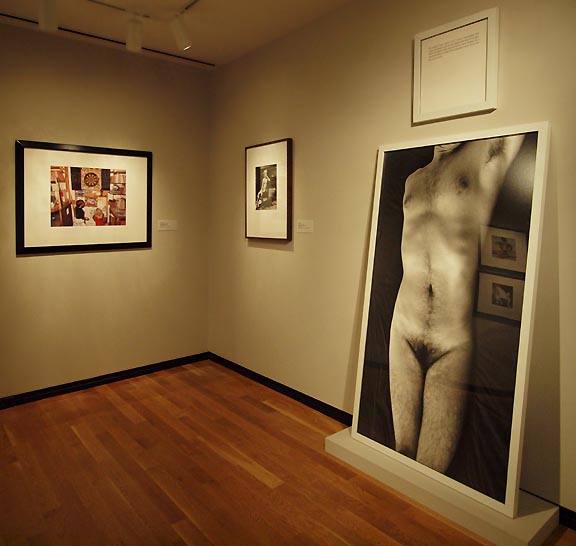
|
||
|
Portland art blog + news + exhibition reviews + galleries + contemporary northwest art
|
||
Flesh & Bone at PAM
On loan from the British Museum, the Body Beautiful show at Portland Art Museum is creating quite a buzz with its strong classical greek depictions of the human form in sculpture, jewelry, and idols. But don't forget to see PAM's complementary showing of photography examining the body, Flesh & Bone. Pulled from PAM's permanent collection, this group of images explores the potential of the body as a site of expression in modern and contemporary photography and spans three rooms on the second floor of PAM's Jubitz Center.
The next wall over, the atmosphere the body is found in raise questions about the camera as an extension of the body. When captured in a natural landscape, the body and camera appear at harmony in a natural setting in which they are both immersed. The camera acts as a unifying force by incorporating the body into a landscape it creates through the image. In the more mechanical, urban setting, the camera as an extension of the body acts as a voyeur or a matter of surveillance by isolating the body and the camera seems to be functioning as a part of the mechanics of the city. In Eleni Mousakiti's In Limbo, 1999-2004, we see people captured through the physical mechanics of cities, the plexiglas windows of underground metro, the frame of a surveillance camera, or a door emptying onto an urban street. These mechanics, in a certain sense become extensions of our bodies as well by becoming a lens in which we see each other in this urban space. Don't pass over the work of Robert Frank, where themes of identity and cultural politics arise in his series of color work, In Mabou: Wonderful Time with June. This shot after Mr. Frank's all black and white book, 1958's the Americans and conceptually delivers narrative in autobiographical nature, the images evoke the feeling we are within Frank's own eyes and camera. as well as the Americana sensibilities Frank's work is known for. The themes of institutional identity or the body within a greater system is seen in Paul D'Amato's Boy Swimming in Pool, from inner city Chicago. The imagery of concrete and water is industrial and the repeated tiled, pattern of the pool forms a structure in which its subject is contained. The water rolling down the young African-American body pairs his body with this structure and therefore institutionalizes the body. This symbolic imagery is both expository and revealing and calls us to question where we stand, or swim in the greater power structures we are a part of.
Hidden in the final room are photos depicting the body as a site of conflict through documentary and war photography as seen in Nina Berman's documentation of post trauma wounded soldiers and her piece, Cpl. Typson Johnson. The eerily-lit image shows a soldier lying alone in bed, his scars and wounds sometimes illuminated and other times darkened by the shadows coming off the blinds of the window. It is perhaps a politicized allegory to how the tragedy of war is sometimes revealed, and just as consistently, left in the dark.
Replications of the body, made and inspired by its form are also included in Flesh & Bone. Directly addressing the themes of the Body Beautiful are the PAM's archival shots of Greek and Roman sculpture from the courtyard of the museum in the 1920s and the x-rays of ancient sculptures of heads and bodies from David Maisel's series, History Shadow. Reproductions of the body for medical use is also seen in Sage Sohier's Surgeon with Molds of hands he has repaired. The discussion of extensions and cyborgs of the body through the imagery of casts, prosthetics, and medical care shines in this visual dialogue. The show delivers what the body beautiful does not, the body as a fluid space of honesty and narratives, rather than a frozen ideal, an ever-changing space of politics and contention. The body is a space for interpretation, It illustrates the body as a interpretative entity and shows the immense spectrum of dynamic emotion the body creates. Flesh & Bone Posted by Drew Lenihan on October 19, 2012 at 10:35 | Comments (0) Comments Post a comment Thanks for signing in, . Now you can comment. (sign out)
(If you haven't left a comment here before, you may need to be approved by
the site owner before your comment will appear. Until then, it won't appear
on the entry. Thanks for waiting.)
|
| s p o n s o r s |
 |
 |
 |
 |
 |
 |
 |
 |
 |
 |
 |
 |
 |
 |
 |
 |

|
Site Design: Jennifer Armbrust | • | Site Development: Philippe Blanc & Katherine Bovee | |





